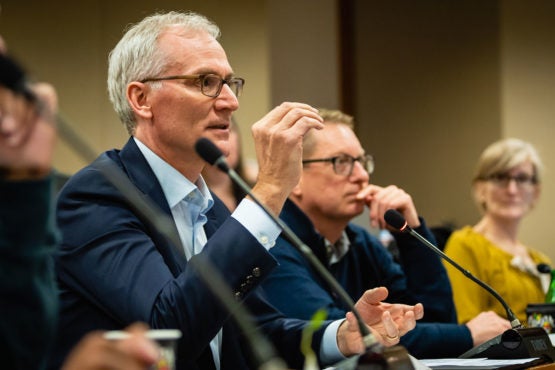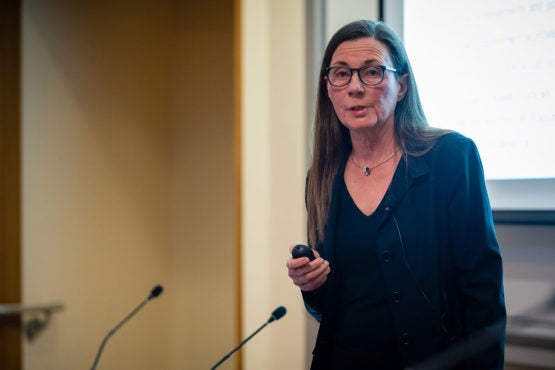Faculty Senate hears findings and recommendations of the Committee on the Professoriate, and an update on Stanford’s response to the novel coronavirus
At the Feb. 6 senate meeting, members of the Committee on the Professoriate presented the committee’s findings and recommendations. President Marc Tessier-Lavigne gave an update on Stanford’s response to the novel coronavirus, and also emphasized the need to extend support and respect to the university’s Chinese and Chinese-American students and scholars.
At the Feb. 6 meeting of the Faculty Senate, three members of the Committee on the Professoriate presented their findings and recommendations on issues related to teaching line appointments and to the status of fellows at designated policy centers and institutes.
In addition, President Marc Tessier-Lavigne gave a short update on Stanford’s response to the recent outbreak of the novel coronavirus and the precautions the university is taking to protect the campus community. He also expressed his firm commitment to the university’s international community.

At Thursday’s meeting, President Marc Tessier-Lavigne updated the Faculty Senate on the university’s response to the coronavirus. (Image credit: Farrin Abbott)
“Our Chinese and Chinese-American students and scholars are an important and vital part of the Stanford family,” he said. “It is very important that we extend our support and our respect to all members of those communities and that we avoid scrutinizing anyone based on race, ethnicity or national origin.”
Tessier-Lavigne emphasized that Stanford’s commitment to sharing ideas and scholarship across borders has not changed as a result of the outbreak of the novel coronavirus, but noted that the university does need to take necessary precautions under the circumstances.
Committee on the Professoriate report
The Committee on the Professoriate, formed by the senate last spring, was charged with considering changes to teaching staff appointments: to create a middle rank of lecturer; and to create the rank of assistant professor (teaching) as the first rung on the ladder in the teaching line now composed of associate professor (teaching) and professor (teaching).
Both changes were recommended by the Provost’s Committee on Lecturers, which presented its findings to the senate in late 2018.
The senate committee was also asked to consider changes to the rank of “center fellow” and “senior fellow” in Stanford’s designated policy centers and institutes.
Currently, there are five designated policy centers and institutes on campus: the Freeman Spogli Institute for International Studies; the Precourt Institute for Energy; the Stanford Institute for Economic Policy Research; the Stanford Institute for Human-Centered Artificial Intelligence; and the Stanford Woods Institute for the Environment.
The Thursday presentation was the first of two discussions on the changes the committee was asked to consider. The second part of the discussion will take place on Feb. 20 at the next senate meeting. At that time, the senate will vote on the recommendations.

Patricia Burchat, co-chair of the Committee on the Professoriate, addressing the Faculty Senate on Thursday. (Image credit: Farrin Abbott)
The members of the committee who presented the report were co-chair Patricia Burchat, a professor of physics, and co-chair Robert Weisberg, a professor of law, and Mehran Sahami, a professor (teaching) of computer science.
“We considered the effect of teaching lines on three things at Stanford,” Burchat said.
“One is generating innovative work in education, part of our mission. Another is attracting and retaining strong contributors to student education at the university. And finally, promoting an educational environment that will allow students to thrive by enhancing student-focused teaching practices and more fully pursuing engaged learning. Sometimes that will come from bringing in people from outside and helping us move in that direction.”
The committee found that departments and schools that hire professors who specialize in teaching and education in their field need the flexibility to recruit and hire junior faculty with training in evidence-based learning techniques.
In terms of criteria for the new position, the committee noted that an assistant professor (teaching) should be an outstanding teacher, and demonstrate the potential for achieving a national reputation in teaching and education.
“More institutions are using ranks equivalent to assistant professor (teaching) to competitive advantage in recruiting educationally focused junior faculty,” she said, adding that Stanford needs to add the position to be able to compete for those people.
Regarding the middle rank of lecturer, the committee found widespread agreement on adding the position, saying it would provide a means for recognizing the work of long-term lecturers, and potentially provide incentives for newer lecturers to sustain high-quality work and pursue professional development as a way to achieve the rank.
During his part of the presentation, Sahami said no units would be required to adopt the new middle rank of lecturer, tentatively called “advanced lecturer,” and would have the freedom to make their own decisions on adding lecturers at that rank based on their particular needs and financial considerations.
He said that after getting a lot of feedback, the committee decided that the new rank should not be considered an intermediate step in a three-tier career track from lecturer to advanced lecturer to senior lecturer.
“Rather, the advanced lecturer position is a rank that reflects more experience and evidence of contribution than the lecturer rank,” he said. “So what distinguishes a senior lecturer is a senior lecturer would remain defined as a role involving significantly higher levels of responsibility than that of lecturer or advanced lecturer, such as directing a program or making significant educational contributions beyond high-quality teaching.”
The committee found that in institutes and some schools, center fellows help attract excellent interdisciplinary junior faculty to Stanford in diverse areas, including energy, the environment and international relations.
In interviews with people across campus, the committee found support for granting full membership in the Academic Council to center fellows who hold at least a partial Academic Council appointment, and membership in the Academic Council to center fellows who hold a 100 percent appointment in a designated policy institute – i.e., with no appointment in an academic department.
Senators raised a variety of questions following the presentation, including the difference between an assistant professor (teaching) and a lecturer, the difference between an advanced lecturer and a senior lecturer, stand-alone hires in policy institutes, and whether creating new teaching staff ranks would put pressure on units to use them.
Committee recommendations
The committee’s report, which was distributed to the senate last week, included detailed findings and more than a dozen recommendations. Among the recommendations:
- Create an “advanced lecturer” rank above the existing lecturer rank.
- Create the rank of assistant professor (teaching), and establish clear policies and expectations for the position.
- Grant full membership in the Academic Council of the University to center fellows who hold at least a partial Academic Council appointment in a department or school.
- Grant membership in the Academic Council to center fellows who hold a 100 percent appointment in a designated policy institute.
- Modify university policy to ensure that the rank of senior fellow is comparable in stature to that of a tenured professor or tenured associate professor.
- Eliminate professorial lines that are no longer in use: associate professor and professor (clinical), (applied research) and (performance).
The proposed changes would require approval by the Faculty Senate, which is expected to vote on the committee’s recommendations at its Feb. 20 meeting.
Response to coronavirus
Addressing the outbreak of the novel coronavirus, Tessier-Lavigne said Stanford’s Public Health Policy Committee, made up of people from around the university, is meeting on an ongoing basis to assess the situation and guide the university’s response as the crisis continues to mount.
He said the federal Centers for Disease Control and the Santa Clara County Public Health Department consider the risk of the disease in the United States and in the Bay Area to be low. As of Wednesday, two cases have been reported in Santa Clara County.
Tessier-Lavigne said Stanford is taking several precautions.
The university is restricting all travel to China and asking community members who have returned from mainland China – with or without symptoms – to self-isolate until 14 days have passed since their return.
He said the university is also encouraging members of the Stanford community to take a common-sense approach to prevent the spread of any infectious disease, including coronavirus: Stay home when sick; wash your hands frequently; clean and disinfect shared surfaces; and get a flu shot.
For more information, visit the Stanford Environmental Health & Safety website, which includes a list of frequently asked questions and answers about the university’s response to and prevention of the coronavirus.
The full minutes of the Feb. 6 meeting, including the discussion that followed the presentations, will be posted on the Faculty Senate website.
The next senate meeting is scheduled for Feb. 20.
